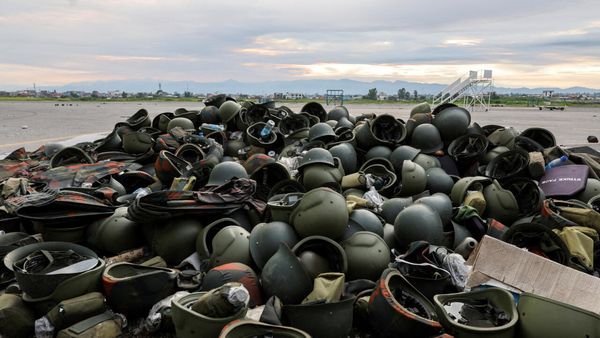
It’s hard to imagine a more evocative symbol of forlorn hopes and lost utopias in contemporary Britain than the destruction of Charles Rennie Mackintosh’s magnificent building the Glasgow School of Art by not one but two fires. Every generous detail of the place expressed a buoyant vision of a shared artistic idealism that made it the greatest work of early modernism in the British Isles. In the most perturbing of three very different spaces in his outstanding exhibition at the Fruitmarket Gallery, Turner prize winner Martin Boyce, who attended the art school, mourns this tragedy and asks for answers.
Black and white photographs are laid out on a long padded table with the respectful formality of a forensic laboratory. Who has died here? There is no body, just soot-stained walls, a ruined roof under a plastic tent, fire-damaged artworks.
These shadowy images were photographed inside Glasgow School of Art after the fire that ravaged it in 2014, but before the second fire that reduced it to a husk in 2018. They exhibit an injured yet still living creation for detectives to analyse. You can see from this evidence table that in spite of its ordeal, Mackintosh’s masterpiece was clearly salvageable after the first fire. Now all its beautiful interiors are lost and a largely new structure is being slowly and controversially constructed from the empty brick shell.
I recommend starting here in the Warehouse, the Fruitmarket’s most atmospheric space, which Boyce has turned into a deathly crypt. For the rest of this rich show is gleefully elusive, abstract and determined to resist fixed meanings. When you find the photographs of the burned art school behind eerie curtains of white plastic chaining amid what feels like a melancholy lumber room, with a TV aerial sprouting from a Brancusiesque column and dead leaves scattered around concrete seating and a sculpted waste bin, they pack a clarifying punch. If you begin here, in the shadows, the rest of the show is a gradual ascent from hell to heaven.
In the white, ground floor gallery Boyce orchestrates a dazzling display of contradiction and restlessness. Every time you think you’ve pinned him as an artist, he changes his entire nature. The most authoritative works – the ones, if I were a wealthy art collector, I’d have bought on the spot – are abstract “paintings” made from building site rubbish. A panel the size and shape of a vertical Rothko canvas is composed of wooden floorboards painted grey, with an irregular hexagonal hole containing pink chipboard layered over a bright yellow corrugated grille.
It has the brilliance of Jasper Johns or Robert Rauschenberg. Like them, Boyce sees the beauty hidden in overlooked, quotidian trash; but his ordinariness is more brutal. Unredeemed, soulless crap attracts him. The space is punctuated by corrugated plastic sheets framed in blue steel rectangles. Another big work consists of two perforated metal sheets painted dreamy blue and violet-grey with a green plastic 1980s phone stuck on to one of them.
The phone almost parodically suggests hope, even transcendence. I found myself thinking of the phone Andy Warhol offers to Jim Morrison in Oliver Stone’s film The Doors, telling him he can speak to God with it.
As soon as you think you have Boyce figured out, however, he throws something bizarre, even daft, at you. A photograph of the shadow of a biomorphic sculpture, which looks like an Arp or a Miró, is in fact of one of his own sculptures in the warehouse space. A little photograph of a chair propped against a door is mirrored by an actual wooden chair balanced against a real door at the far corner of the gallery. Except that this chair is a crafty masterpiece, intricately constructed and elegant, which recalls the work of Mackintosh himself.
Boyce can do it all, you think. He can capture the true plenitude of life, from abysmal waste and ugliness to ethereal beauty and luxury. Then upstairs, in the gallery’s largest, skylit space he appears at first glance to have done absolutely nothing. A big, empty whiteness greets you at the top of the stairs, until you notice delicate flag-like shapes of white and pink, neatly cut from yet more perforated builder’s material, suspended above. The panelled walls contain frame-like shapes as if to contain paintings. Around the spacious floor, leaves are scattered. They are a lovely autumnal red.
This could be a derelict ballroom or theatre. A grey fireplace has been set into the panelling and in the grate there is a little model theatre stage, with an austere modernist set that would be perfect for Ibsen.
It’s all theatre, Boyce may be telling us, the way you can create moods of anger, despair, comedy and prayer just by playing with abstract spaces and objects. Yet whatever is playing in the tiny theatre in the hearth, you know it is real and serious – a modern tragedy. This exhibition has an exquisite beating heart. Every bit of painted rubbish is an image of the joys and sorrows of our lives. Glasgow School of Art could not have a more poignant elegy.
• Martin Boyce: Before Behind Between Above Below is at Fruitmarket, Edinburgh, from 2 March to 9 June







